Doppler of the Ductus Venosus in Detection of Chromosomal Abnormalities
To study the value of Doppler ultrasound of the ductus venosus in the screening for chromosomal abnormalities at 10-14 weeks of gestation.
Objective: To study the value of Doppler ultrasound of the ductus venosus in the screening for chromosomal abnormalities at 10-14 weeks of gestation.
Patients and Methods: The ductus venosus flow velocity waveforms (figure1) and nuchal translucency (NT) were obtained in 315 pregnancies. In 113 cases a cytogenetic study was performed on material obtained from a biopsy of the chorionic villus, and in 202 cases the post-natal phenotype was used as a basis for the result. We employed the following criterions for the suspicion of chromosomal abnormalities: a reverse or absent flow during atrial contraction in the ductus venosus and NT above the 95th centile. We calculated the sensitivity (S), the specificity (E), the negative predictive value (NPV) and positive predictive value (PPV) for each one of the above items.
Results: There were 25 cases of chromosomal abnormalities (table 1). Of these abnormal cases, the ductus venosus blood flow during atrial contraction was absent (1 case) and reversed (22 cases, figure 2), sensitivity was 92.0 %. In the group of normal fetuses (288 cases), 7 evaluations demonstrated alterations in the Doppler of the ductus venosus (E=97.6; PPV=76.7% and NPV=93.31%), the false-positive rate was 2.4% (figure3). The results concerning the measurement of the NT is in the figure4(S=76.0%; E=95.5%; PPV=59.4% and NPV=97.9%).
In this present study, ductus venosus Doppler velocimetry, particularly during the atrial contraction, was more accurate than the NT thickness measurement in the detection of chromosomal abnormalities (figure 5) and showed a significant contribution in distinguishing between the normal fetuses and abnormal karyotype fetuses (p<0.001).
Conclusions: Our preliminary results suggest that the Doppler of flow blood velocity in ductus venosus during atrial contraction may be combined with nuchal translucency thickness to provide an effective screening for fetal aneuploidy in the first trimester of pregnancy. This association may reduce the false-positive rate of nuchal translucency thickness measurement in the ultrasonography screening for chromosomal abnormalities and may reduce the need for invasive testing without decreasing the sensitivity of the first trimester screening.

Fig. 1- Unidirectional and triphasic waveform of the ductus venosus blood flow velocity (normal fetus (46XX) of 12 weeks of gestation. The first peak occurs during ventricular systole (S) and the second during ventricular diastole (D) and the phase "a" represents the end of diastole and atrial contraction.
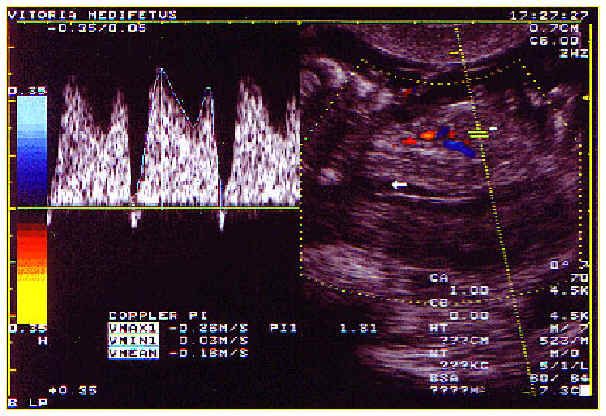
Fig. 2 - Characteristic ductus venosus waveforms in fetus with trisomy 22 with 12 weeks of gestation. Note the reversed flow velocity during the atrial contraction. The nuchal translucency thickness was 2.5 mm in this case.
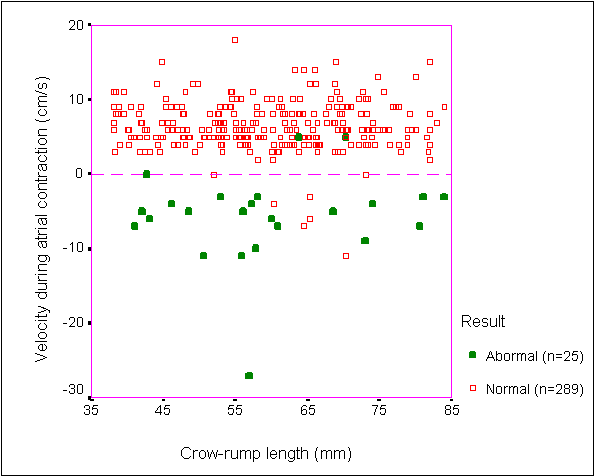
Sensitivity = 92.0%; Specificity = 97.6%; PPV = 76.7% and NPV = 93.3%
Fig. 3 -Relation between the flow velocity during atrial contraction in the ductus venosus and crow-rump length at 10-14 weeks of gestation in normal fetuses and abnormal karyotype fetuses.
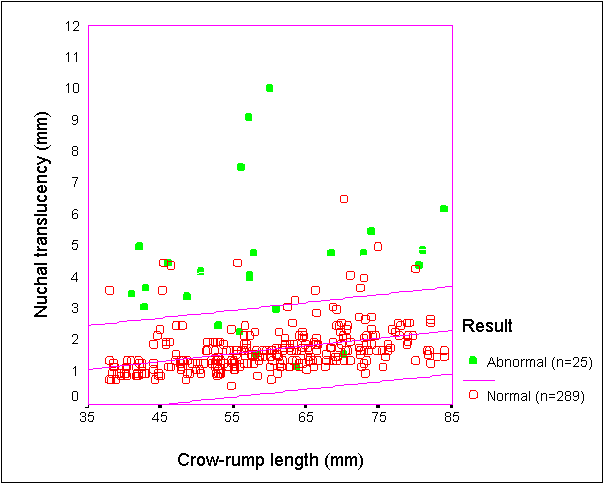
Sensitivity = 76.0%; Specificity = 95.5%; PPV = 59.4% and NPV = 97.9%
Fig. 4 -Relation between the nuchal translucency thickness and crow-rump length at 10-14 weeks of gestation in normal fetuses and abnormal karyotype fetuses.
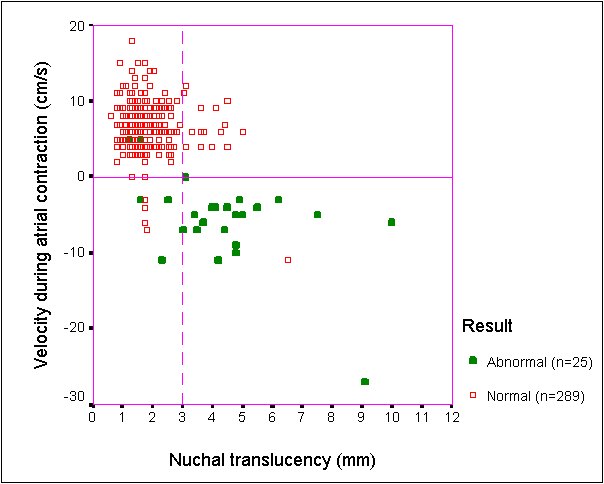
Fig. 5 -Relation between the flow velocity during atrial contraction in the ductus venosus and nuchal translucency thickness at 10-14 weeks of gestation in normal fetuses and abnormal karyotype fetuses.
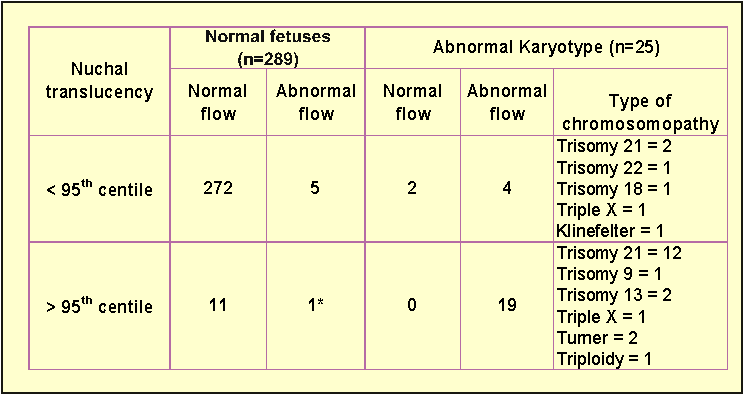
Table 1 - Blood flow velocity in the ductus venosus of normal fetuses and abnormal karyotype fetuses in relation to the NT at 10-14 weeks of gestation. A reverse or absent velocity during atrial contraction was considered an abnormal flux. The type of chromosomopathy is specified. The asterisk signifies the presence of hypoplasia of the left heart (major cardiac malformation).
References:
References
1 - Areias JC, Matias A, Montenegro N, Brandão O. Early Antenatal diagnosis of cardiac defects using transvaginal Doppler ultrasound: new perspectives? Fetal Diagn Ther;13:111-4,1998.
2 - Borrell A, Antolin E, Costa D, Farre MT, Martinez JM, Fortuny A. Abnormal ductus venosus blood flow in trisomy 21 fetuses during early pregnancy. Am J Obstet Gynecol;179:1612-1617,1998.
3 - Huisman TWA, Stewart PA, Wladimiroff JW, Stijnem T. - Flow velocity waveforms in the ductus venosus, umbilical vein and inferior vena cava in normal human fetuses at 12-15 weeks of gestation. Ultrasound Med Biol;19:441-5,1993.
4 - Kiserud T, Eik-Nes SH, Blass HG, Hellever LR. Ultrasonographic velocimetry of the fetal ductus venosus. Lancet;33:1412,1991.
5 - Matias A, Montenegro N, Areias J, Brandão O. Anomalous fetal venous return associated with major chromosomopathies in the late first trimester of pregnancy. Ultrasound Obstet Gynecol;11:209-13,1998.
6 - Matias A, Gomes C, Flack N, Montenegro N, Nicolaides KH. Screening for chromosomal abnormalities at 10-14 weeks: the role of ductus venosus blood flow. Ultrasound Obstet Gynecol;12:380-384,1998.
7 - Montenegro N, Matias A, Areias J, Castedo S, Barros H. Increased fetal nuchal translucency: possible involvement of early cardiac failure. Ultrasound Obstet Gynecol;10:265-8,1887.
8 - Nicolaides KH, Azar G, Snijders RJM, Gosden CM. Fetal nuchal edema: associated malformations and chomosomal defects. Fetal Diag Ther;7:123-131,1992.
9 - Nicolaides K, Brizot M, Snijders R. Fetal nuchal translucency: ultrasound screening for fetal trissomy in the first trimester of pregnancy. Br J Obstet Gynecol;101:782-786,1994.
10 - Snijders RJM, Noble P, Seberi N, Souka A, Nicolaides KH. UK multicentre project on assessment of risk of trisomy 21 by maternal age and fetal nuchal translucency thickness at 10-14 weeks of gestation. Lancet; 351:343-346, 1998.
S1E4: Dr. Kristina Adams-Waldorf: Pandemics, pathogens and perseverance
July 16th 2020This episode of Pap Talk by Contemporary OB/GYN features an interview with Dr. Kristina Adams-Waldorf, Professor in the Department of Obstetrics and Gynecology and Adjunct Professor in Global Health at the University of Washington (UW) School of Medicine in Seattle.
Listen
Study shows a healthy prenatal diet could be upstream obesity prevention strategy
December 26th 2024"Our findings support the recommendation of a healthy diet based on the current guidelines (as measured by the HEI) during pregnancy, since it may reduce patterns of infant growth outside reference ranges."
Read More
Early pregnancy cannabis use high in states with recreational legalization
November 11th 2024A population-based time-series analysis California before, during and after legalization show a rising trend in women using cannabis while pregnancy especially when the state has legalized the drug.
Read More
